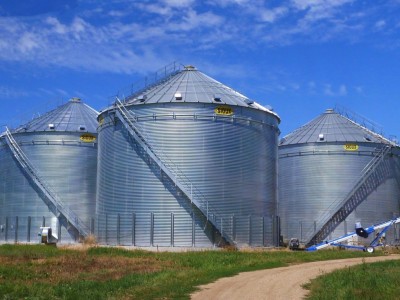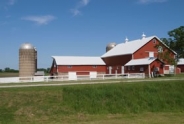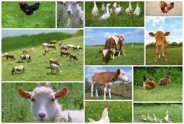Don't Become a Statistic: Grain Bin Safety Tips

By Kristina TeBockhorst: Iowa State Extension
Many across the US have set aside February 20-26 as Grain Bin Safety Week in order to grow awareness of the hazards associated with grain storage. Many of the ways to increase safety when working and living around grain storage involve basic safety practices, but more education and enforcement is needed on the farm.
Over two-thirds of US grain is stored on the farm without OSHA standards for safety protocols. It is up to you to keep yourself, your employees, your spouse, kids, and grandkids safe from grain bin hazards.
Flowing grain can trap someone standing on the grain in just 4 to 5 seconds and that person will be completely covered in grain in about 22 seconds, according to the Grain Handling Safety Coalition.
There were over 35 reported entrapment incidents in the US in 2020 and 20 of them were fatal, based on a report by Purdue University. Also based on Purdue's report, the average age of grain entrapment victims is 58, however, youth under the age 21 have accounted for 20% of annual cases in the past. Parents and employers should take responsibility for keeping youth safe from grain bin incidents by educating them on grain bin hazards and by assigning safe and appropriate tasks.
The most dangerous scenarios around stored grain involve flowing grain, bridged grain, and vertical grain walls.
- Flowing grain accounts for the majority of the grain engulfment incidents and has become more dangerous as newer grain unloading equipment unloads at faster rates. When grain is unloaded from below, such as in grain bins, grain piles, trucks, and even grain wagons, anyone standing on the grain can be pulled down toward the outlet and are often stuck faster than they can react.
- Bridged grain occurs when a crust or clumps of spoiled grain forms on top of the grain and grain is removed, leaving a void space below the crust. The crust can collapse under a person's weight, potentially burying them in the shifting grain.
- Vertical grain walls form when spoiled grain clumps stick to the wall and become dangerous when grain is dislodged and falls like an avalanche.

Out-of-condition grain increases the risk of entrapment.
Make grain condition monitoring a weekly task on the farm, especially when temperatures start to rise in the spring. Check grain for signs of spoilage, such as crusting, damp/warm spots, musty or sour odors, or rising CO2 levels.
A few good grain storage practices to keep grain in good condition include:
- only store good quality and clean grain,
- store at the recommended moisture content,
- don't attempt to store longer than half of the maximum allowable storage life,
- run aeration cycles to maintain cool and even temperatures,
- core every grain bin (or clean the grain) to remove fines and broken kernels.
Find more grain storage tips in a recent article and find other grain storage resources here.
Safety practices everyone should follow:
- Post warning signs on bins and at all entry points to make everyone aware of the hazards.
- Restrict access to bins and piles so that unauthorized people and youth can't enter.
- Work from outside the bin and above the highest point of grain.
- Aim for zero entry into the bin.
- If entry is essential, use proper safe entry procedures including:
- locking out and tagging out all grain unloading equipment,
- having an observer,
- using a life harness.
Other grain bin related injuries or deaths can come from respiratory hazards of grain, falls, electrocution, or dust explosions. To avoid these:
- wear NIOSH-approved respirators certified for grain dusts,
- upgrade ladders with cages or use staircases,
- steer clear of overhead power lines and lower augers before moving,
- conduct regular dust cleaning and servicing of bearings in elevators and grain legs.
Additional Resources:
Home | Grain Handling Safety Coalition (grainsafety.org)
Summary of Grain Entrapments (purdue.edu)
2021 Stored Grain Management | Integrated Crop Management (iastate.edu)
Grain Storage Resources | Iowa Grain Quality Initiative (iastate.edu)
Upcoming Events
WNY Pastureland Conversion & Soil Health Field Day
July 16, 2025
Middleport, NY
Join American Farmland Trust for the Western New York Soil Health Field Day on July 16, 2025, at Zeliff Farm in Middleport, NY, from 9:00 AM-3:15 PM. Learn about pasture conversion, soil health benchmarking, biochar in grazing systems, and best grazing practices. Plus, enjoy hands-on demos with the NY Soil Health Trailer, drones, and cover crops! Check out the attached agenda for more information about the field day and REGISTER HERE. Zeliff Farms is a regenerative beef operation who has recently partnered with AFT on outreach and education to farmers including learning circles and evaluating biochar effects on soil health.
IPM Strategies to Protect Corn and Soybean Seed in NY
July 30, 2025
Hamburg , NY
SWNYDLFC and Cornell IPM are hosting a grower meeting to discuss integrated pest management strategies for protecting corn and soybean seed in New York.
FAMACHA Training for Sheep and Goat producers in Woodhull NY
August 13, 2025 : FAMACHA Training in Woodhull
Woodhull, NY
Join us for a discussion and hands-on training for internal parasite integrated pest management in sheep and goats. Certification is available to all students participating in the workshop.
Announcements
No announcements at this time.





